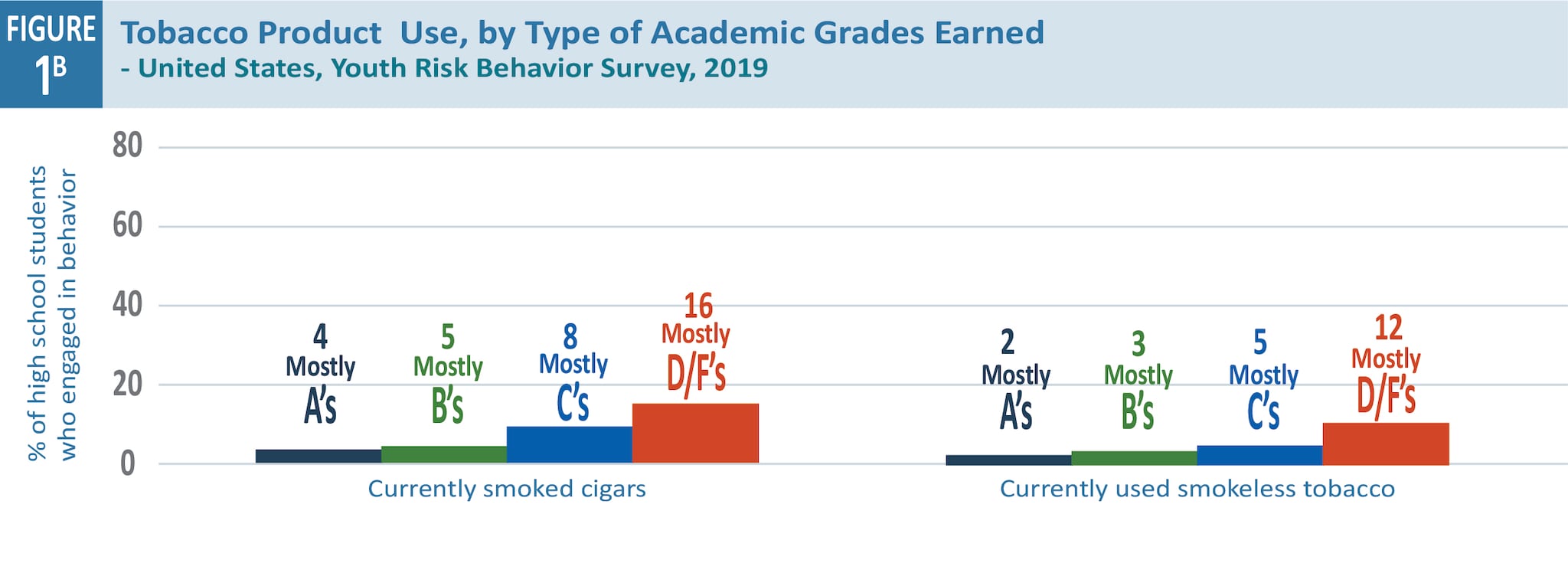At a glance
- 2019 Youth Risk Behavior Survey (YRBS) connects students who have higher grades with being less likely to use tobacco.
- School health professionals, officials, and decision makers can use these findings to understand this connection. They can also reinforce policies and practices that discourage tobacco use.
Key Findings
Compared to students with lower grades, students with higher grades are less likely to:
- Use an electronic cigarette or other electronic vapor products.
- Smoke cigarettes.
- Smoke cigars.
- Use smokeless tobacco.
Figure 1A: YRBS 2019*
Tobacco product use behaviors, by type of academic grades earned—United States, Youth Risk Behavior Survey, 2019*

Summary
Findings refer to behavior on at least 1 day during the 30 days before the survey.
- 26% of U.S. high school students with mostly A’s currently used an electronic cigarette or other electronic vapor products. The products may include e-cigars, vape pens, e-hookahs, and hookah pens, and mods (such as JUUL, Vuse, MarkTen, and blu). This compares to 52% of students with mostly D's/F’s.
- 4% of U.S. high students with mostly A’s currently smoked cigarettes. This compares to 19% of students with D's/F’s.
Figure 1B: YRBS 2019*
Tobacco product use behaviors, by type of academic grades earned—United States, Youth Risk Behavior Survey, 2019*

Summary
Findings refer to behavior on at least 1 day during the 30 days before the survey.
- 4% of U.S. high school students with mostly A’s currently smoked cigars (cigars, cigarillos, or little cigars). This compares to 16% of students with mostly D's/F’s.
- 2% of U.S. high students with mostly A’s currently used smokeless tobacco: chewing tobacco, snuff, dip, snus, or dissolvable tobacco products (such as Copenhagen, Grizzly, Skoal, or Camel Snus). This behavior does not count any electronic vapor products. The 2% noted above compares to 12% of students with mostly D's/F’s.
Disclaimer
*Figure 1A and Figure 1B illustrate the percentage of students who engaged in each health-related behavior, by type of grades mostly earned in school (mostly A's, B's, C's, D's/F's) (row proportions). The percentage of students who did not engage in each health-related behavior are not shown.
However, the percentages of students who did and did not engage in each health-related behavior (by grades earned) sum to 100%. Analyses controlling for sex, race/ethnicity, and grade in school confirmed a significant association between tobacco product use behaviors and academic grades.
Conclusions
These YRBS results show evidence of a significant association between tobacco product use and academic grades. More research could help determine:
- Whether lower grades in school lead to tobacco product use behaviors.
- If some other factors lead to these tobacco product use behaviors.
- If tobacco product use behaviors lead to lower grades.
There is a close relationship between health and education. Working together, education and health agencies, parents, and communities can ensure that students are healthy and ready to learn in school. Find out more about the connection between health and academic achievement on CDC's Health and Academics web page.
About the Data
The Youth Risk Behavior Surveillance System (YRBSS) monitors priority health-related behaviors among youth and adults in the United States. In particular, YRBSS monitors behaviors that contribute to the leading causes of death, disability, and social problems.
YRBS is conducted every 2 years during the spring. YRBS provides data representative of students in grades 9–12 in public and private schools nationwide. In 2019, students completing the YRBS were asked, “During the past 12 months, how would you describe your grades in school?” and given seven response options (mostly A’s, mostly B’s, mostly C’s, mostly D’s, mostly F’s, none of these grades, not sure).
In 2019, YRBS results showed that:
- 38.0% of students received mostly A’s.
- 37.1% received mostly B’s.
- 16.0% received mostly C’s.
- 4.6% received mostly D’s or F’s.
- 4.3% reported receiving none of these grades or were not sure.
